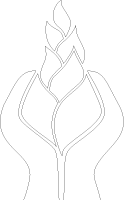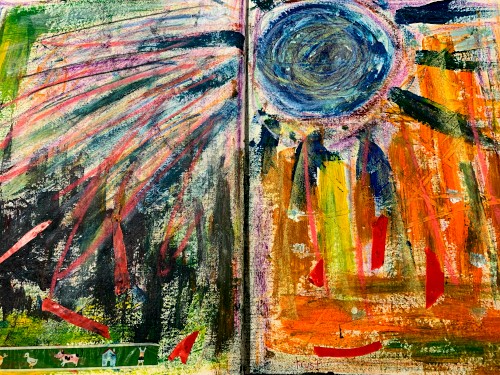“Just make a mark,” Tammy said, as she boldly drew a messy line on her paper.
I had been the kind of girl who coloured between the lines. I wasn’t comfortable with things that were uncomfortable. Things I didn’t know how to do. Things that were messy. Yet something had been shifting and I knew there were things inside, things that didn’t fit between the lines, that wanted out.
“Just make a mark,” she said. And something in that statement melted for a moment the internal messages that had been keeping me captive. The ones that were whispering not so quietly, “Don’t you dare make any mark unless you know first that it is right!”
Let me back up a bit. I lived for the last few years on a little island known for the artists that inhabit it. One of them lived down the street and I got to know Tammy over soup and conversation. I admired her work — it was bold and raw and creative. But there was something I admired even more, and that was her ability to facilitate expressive art in others.
Permission. It’s a powerful word and an even more powerful construct. It holds the power to loosen things that have been stuffed or stagnant for years … decades even. When we experience permission, we open a portal. And if we let it do its magic, we are given a reprieve from holding in or holding back.
What about invitation? That’s a powerful word too. It offers something a little different than permission’s gentle “it’s okay.” Invitation has more of a “let’s do this!” kind of energy. “Let’s bring this to the table, or the wall, or the floor.… Let’s bring something IN you OUT into existence.”
Don’t we all long for this kind of invitation? And don’t we yearn to hear that it’s okay to be ourselves?
Well, when I met Tammy, I experienced both permission and invitation. Through her playful facilitation, she had me expressing things with paint, crayons, and other art supplies that I had been too afraid (or intimated by) to ever use. And she had me expressing it in a way that matched what was going on inside.
My friend Tammy, through her own transformative experiences, knew the secret was not about teaching the right technique or following a certain method. The magic came when she could create a safe place free of harmful messages. If she could do this, she was confident that the rest would unfold spontaneously.
But this requires a bit of space. Some freedom from scheduled activities and screens. Some freedom to try things out, to not get something “right” — the first time, or the second time, or maybe ever. Because maybe (you can probably guess what I’m going to say here), getting it “right” isn’t the goal worth aiming for. Maybe it should be more about getting it “out.”
In this space, you can trust that whatever comes out isn’t going to be held against you. And it’s not going to mess up your relationships or get you in trouble with the people you care about. In the play mode, there is both safety and freedom. I don’t know about you, but this is the kind of space I want to facilitate for those I care about. Yes, what comes out may be messy or loud. But the alternative is even more messy if it stays on the inside.
I’ve been sharing about my experience with emotional expression through art, but art is not the only way. There are so many beautiful outlets we have at our fingertips. We can even find them for free.
Music. Movement. Writing. Poetry. Drama. Story. Our culture used to hold these as sacred for us, so we didn’t even have to think about how they were serving us. But most of us have lost this cultural wisdom, and we are left to find our own way in bringing these practices back into our lives, and the lives of those we care for.
People sometimes ask me, how do I know if something is play? It may sound like a simple question, but it is not so clear cut. Those cultural outlets I listed above, those can be play; but these same things could also easily be turned into work. Cooking can be play, but if you have to get dinner on the table in five minutes to feed your family, it more likely feels like work in that moment. It is not the activity itself that defines something as play, but the way you enter into it.
If you are not sure, here are some guiding questions to help you discern:
- Does it feel like work? If you are focused more on the outcome than the process, you are likely operating out of the work mode and this won’t be a safe place for emotions to come out and play.
- Do you feel like someone is evaluating you? This could be a message (real or imaginary) coming from society, your parents, your partner, or more likely, your self. If you are feeling pressure to perform, this will not lead to the kind of playfulness that leads to expression.
- Do you feel like your guard is up? If you don’t feel safe, physically or emotionally, you are more likely in alarm mode, which again, will make it hard to find your play.
On the other hand, if there is room to try something without fearing repercussions or if you experience some freedom to say or do what you feel moved to say or do (or sing or scream), you may be in the good and trustworthy hands of Play herself. Trust her if you can. Her wisdom has been with us since the beginning of time.
And so, dear readers, I wish for you both permission and invitation. Permission to open the door, and an invitation to bring whatever is in there to come out. For yourself, for your child, and for anyone else who needs a little help finding the kind of play that will help them express what’s inside.
__________________________________________
Editors note: Tamara will be offering an opportunity to dive deeper in to the practice of facilitating play for others – whatever your role – starting online in February 2024.
For more information:
And to find out more about Tammy’s expressive art, you can find her at:

